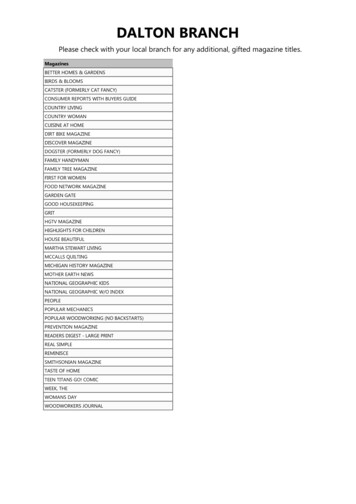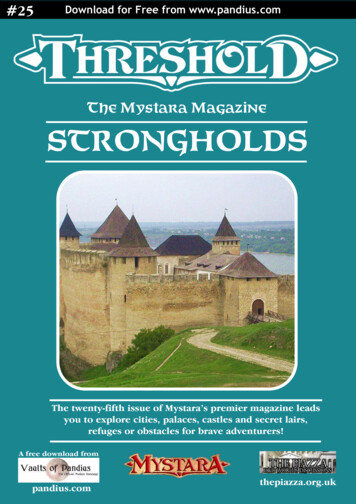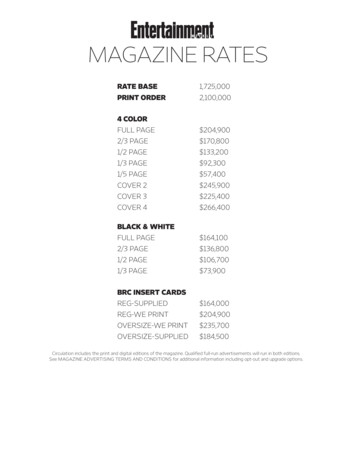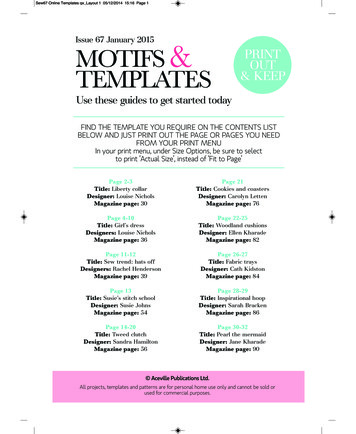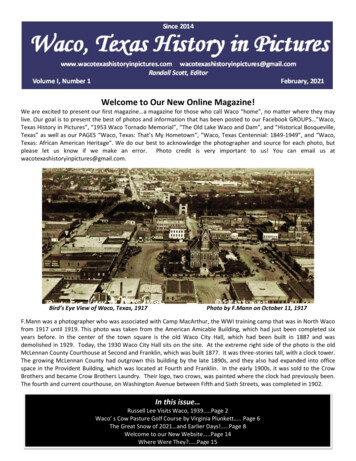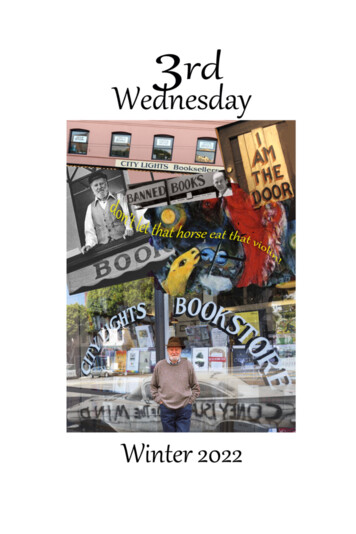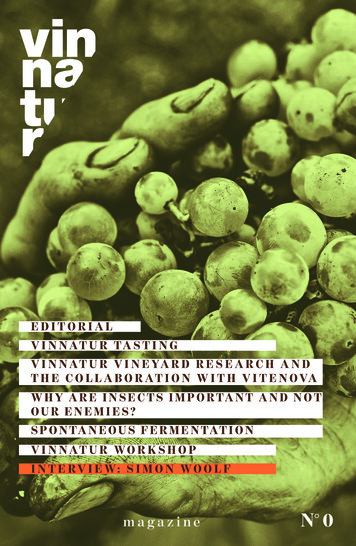
Transcription
EDITORIALV I N NAT U R TAS T I N GV I N N A T U R V I N E YA R D R E S E A R C H A N DT H E C O L L A B O R A T I O N W I T H V I T E N O VAW H Y A R E I N S E C T S I M P O R TA N T A N D N O TOUR ENEMIES?S P O N TA N E O U S F E R M E N TAT I O NV I N NAT U R WO R K S H O PmagazineN 0PAG 1I N T E R V I E W: S I M O N W O O L F
BEYO N DOR GAN I CEDITORIALby Angiolino Maule (President)PAG 2In recent years, organic and biodynamicfarming has grown exponentially inEuropean viticulture, even in largecompanies. I consider this trend positivefor everyone. It is finally understood that thisis the only way that guarantees a future forour soils and our terroirs. In the early yearsof this “boom”, the lack of knowledge and thefrenzy saw the proliferation of unpreparedprofessional figures and unreliable solutions.The viticulture that we intend, that “morethan organic”, does not have a unique recipefor everyone, but it is made of small steps, lotsof knowledge and knowledgeable winemakers.I founded VinNatur to encourage the sharingof knowledge and skills among winemakers.The exchange of ideas between us producerssoon proved insufficient to provide reliableanswers to the problems of a truly naturalviticulture and enology. For this reason, since2009 we have been working with public andprivate scientific institutions, able to givepractical results that are easily applicable towineries. Some of the ongoing projects aredetailed in the following pages.Today, with VinNatur, entomologists,botanists and microbiologists specializein scanning the living part of the soil. Inaddition to understanding the state of healthof the vineyard, we must understand howto strengthen it, how to avoid human errorsthat spoil the balance of nature. The mostambitious aim is to eliminate the copper andsulphur used to fight vine diseases and toobtain stable and good wines without usingsulphites and other added products. Thisinformation is at the complete disposal of allthe associated winemakers and many, withgreat determination and courage, are activeand ready for experimentation.One tool to prove that what we claim is true isthe analysis of pesticide residue, carried out onthe wines of all the associates every year. Theremoval of producers in whose wines we havefound pesticides is categorical, I think it is aduty to the consumer. In 2016, we voted uponand approved an even more effective tool: the“VinNatur Wine Production Charter” whichoutlines all the admitted and not admittedpractices in the vineyard and in the cellar.We are collaborating with five of the bestItalian certification bodies for the first phaseof checks that, in 2018, involved 50 wineries.In 2019, these checks will be extended andrefined. Only when these checks have beencompleted will the charter be strong and nolonger based on a simple self-certification bythe winemaker.In parallel, another project which I stronglypushed for was the “VinNatur Workshop”.An event dedicated to the internationalpress, aimed at spreading our philosophybeyond national borders; a new way to bringVinNatur wines to the attention of externaland authoritative personalities. One thingwe are very proud of is being considered aspringboard for the many young people whojoin our association every year: small, curious,with a great desire to produce unique and rarewines!
VINNATUR TASTING:THE SIXTEENTHEDITION IS BACK BUTWITH A FEW CHANGEST O R E N O VA T Enews from the scientific research projects, interms of analysis and experimentation on thevineyards, that we support as an association,and on the tools used to ensure compliancewith our Charter. We continue to believethat the dissemination of valuable ideas andcontent is possible thanks to words, but notlimited to such. Figurative art is an engagingand immediate language that we have beenusing and encouraging for the past fouryears, through the “Imagine Your VinNaturTasting” competition, in collaboration withItalian Illustrator. Particularly representativeof the spirit of VinNatur 2019 is the posterby Giulia Perin, with which the artist fromCassola (VI) won the first prize. The work hasbeen described by the author as: “taking timeto be together, both in the relationship betweenthe farmer and the grapes, but also among thepeople who share the pleasure of a beautiful glassof wine and enjoy the moment.”In line with the values of respect for natureand man, the association once again hasdecided to share part of the proceeds fromthe event to Sister Tiziana Maule’s ProgettoAlepè association, which gives medical andsocial assistance to the inhabitants of the city of Alépé, in the Ivory Coast.PAG 3The best results come with time andafter sixteen years of hard workand dedication, the time has comefor a few changes to our main andmost famous event, starting with the name:VinNatur Tasting. This decision was provokedlargely because of the second importantchange in 2019: the new location - the MargrafShowroom. This year, the traditional locationof Villa Favorita was not available due tomajor restoration work. As organizers, weimmediately committed ourselves to finding asuitable and functional area for both exhibitorsand visitors, a commitment that from aninitial need has turned into an interestingopportunity. The interior space at the MargrafShowroom is far larger than we had at VillaFavorita and all the stands are located on onefloor and thus considerably eases the work ofthe exhibitors and the use by all visitors.The main protagonists of the event are the180 producers of natural wine from allover Europe, united in the aim of diffusingtheir idea of making wine, using the mostnatural methods possible, and reducinginterventions in the vineyard and in thecellar to a bare minimum. In other words, theculture of terroir. It was precisely the desireto disseminate and share the issues that aredear to us that led to the creation of VinNaturMagazine, a simple and direct communicationchannel that twice a year will allow us toinform members and supporters of thevarious fronts where VinNatur is committed.In particular, we will focus on the latest
VINNATUR VINEYARDRESEARCH AND THECOLLABORATIONWITH VITENOVARESEARCHby Stefano ZaninottiPAG 4The purpose of the VinNaturresearch in collaboration with theVitenova team is clear: to cultivatea vineyard together with nature inorder to obtain productivity and good qualityof grapes and subsequently, wines. The goalmay seem utopian for many people who workin the sector, because they are accustomedto removing everything that is not avine from the vineyard through differentmethods: insecticides to eliminate “bad”insects, herbicides to remove the “weeds” ,fungicides to keep diseases at bay. All thiswithout thinking that there can be and thatwe can study alternatives. It is precisely thisstarting point that distinguishes a VinNaturwinemaker: to believe and work to cultivate avineyard whilst respecting the vineyard as awhole and its surroundings (including humanbeings). To address the topic, the winemakergoes beyond the technique applied byorganics or biodynamics; there are no prepackaged recipes, each vineyard is differentfrom the other, one technique can work inone vineyard and another does not. Thereis therefore a need for a scientific approach,field observations (which are the basis ofscience but also the Biodynamic approach),respect for times and ways of workingthe land. For this reason, since 2009, I,Stefano Zaninotti, together with agronomistStefano Amadeo and biologist Irene Franco(University of Udine) study and measure thebiological fertility and the vitality of the soil.HOW DID IT START?My first meeting with Angiolino Maule datesback to 2012. At first, Angiolino tested ourapproach in his land for two years, then,given the results, he decided to extendthis experimentation to 24 vineyards of12 wineries belonging to VinNatur in thenorth and middle of Italy. After three yearswe presented the results, which evaluatedthe trends and usefulness of the agronomictechniques promoted to improve fertility. Thedata collected allowed us to create a modelable to predict for different soil types theideal amount of microbial biomass (quantityof microorganisms that populate the soil)that it should contain. In 2016, we decidedto expand the experimentation starting tostudy the quantity and quality of the floraand the insects in the vineyard, with thehelp of the botanist Cristiano Francescatoand the entomologist Costanza Uboni. Theircontribution has allowed us to embark on atotally new and innovative way in viticulture.For the first time, we are no longer studyingthe best way to eliminate or limit insectsor weeds. On the contrary, studying andmeasuring the biodiversity in the vineyardallows for more informed and reasonedagronomic choices to be made, always aimedat preserving or improving the system’sability to return to equilibrium (resilience).This knowledge is of vital importance toVinNatur wineries, because they discoveranother world and a new way of seeingand working their vineyard. With thesethemes, the interest from the companieshas increased from year to year. In the tablebelow are some figures showing the scope ofthe experimentation.
36VIN NAT UR WI NE RI E SITA LIAN REGIO N S17212BIOL OGICAL ANALYSISO F THE S OI LS O IL A NA LYSI SBO TAN ICALSTUDIESENTOMOLOGICALSTUDIES52WHY AREINSECTSIMPORTANTAND NOT OURENEMIES?INSECTS2AGRO NOM I ST S1BIO L OGI ST,1BO TANI ST1E N T OM OL OGI STery often farmers have the instinctto spray insects. And with reason,the damage to the leaves and thefruit makes the winemaker angry,and sometimes even angers the person who isharvesting and treating unhealthy grapes. Itis a feeling which is also part of our daily lives :the bug, the ant, the cockroach, the mosquito,the fly have always been considered annoyingand unwanted intruders. But if we lookclosely at what happens, perhaps we realizethat for any excessive presence, the reasonis an imbalance: for example, an excess ofmosquitoes may be due to the presence oftoo few swallows, a cockroach in the houseor in the cellar is probably the result of alack of hygiene in that place or environment.It’s like that in the vineyard too: if there’s aninsect that does damage it’s because there’s asource of trouble. The good and the bad, it’sjust that: what is the source? Here the studyof entomology, together with an agronomist’seye, can guide the winemaker towards asolution and towards a new equilibrium.PAG 56PROFESSIONSIN VO LVE DVby Costanza Uboni
My work as an entomologist starts fromobservation; first, I place traps to capturethe greatest possible variety of insects in thevineyard and then catalog them and analyzethem in order to draw the first conclusions, atleast from the naturalistic point of view, andidentify the source of the imbalance in thevineyard.An example? We have observed that someproducts for foliar treatments contain anadhesive (to better withstand the rain) withan insecticide effect; whilst you might thinkthat you’re simply fighting a mushroom, youactually find yourself with absolutely nothingleft in the vineyard. At this point, as in a desertor a vacuum, the first one to arrive (usually aharmful insect), finding no antagonist, spreadsvery easily. To reach these conclusions it takesmethod (scientific, from Obrist and Duelli,2009, RBA Rapid Biodiversity Assessment),skills and time (2 months total of “fall traps”in the vineyard, 2 days per sample to analyzeand catalog every single insect).To take this even further, I will give youan example of what we have found in twoadjacent vineyards of Montalcino, one workedconsistently with the VinNatur approach, theother with integrated viticulture:Year 2017VinNatur vineyardIntegrated controlviticulture vineyardN mo r p h o spe c ies7367pr i n ci p a l m o r pho spe c iesregroupings of insects with ae(spiders)N ca rabidsPAG 6predatory beetles of other insects13039N sp r ing tailswingless, small herbivorous insects that likehumus - indicators of good organic presence2917ratio of car nivorous/her b ivorous insectscloser the value is to 1, the closer the ratiois to a natural equilibrium2,353,13N p ollinator s2513As can be seen, the important differencein insects (particularly springtails andcarabids) is exclusively linked to the qualityof the soil, the number of pollinating insects,and the relationship between carnivorousand herbivorous insects. Here too we haveidentified an important disturbance factor:weeding. This is the reason why the numberof individual carabids and springtails is lowerin the integrated control viticulture vineyard,and are indicators of the quality of the landitself. The type of treatments against downymildew and powdery mildew has insteadaffected the number of pollinating insects andthe ratio of carnivorous to herbivorous insects.The Biocontrol index (carnivores / herbivoresratio) is very important from an agronomicpoint of view: when the value exceeds 3, theherbivores are in a clear majority and can thuscreate damage on leaves and clusters. In thespecific case, the phylloxera (insect that causesdamage in the vegetative apices) was muchmore present in the vineyard managed withintegrated viticulture than in the “VinNatur”vineyard that had not been treated with sulfurand had seen the use of a dose of copper equalto 2.4.
SPONTANEOUSFERMENTATIONUNIQUENESSWhen fermentations fail tostart, or slow down, or evenstop before the completetransformation of all thegrape sugars into alcohol by yeasts, it is verylikely that acetic, heterolactic or other harmfulmicroorganisms will develop. These are oftenresponsible for an increase in volatile acidityand for the formation of various substancesthat are unpleasant to taste and smell.Defects in the wine hide the best qualities ofthe “terroir” and cancel all efforts made in thevineyard.To avoid these problems that arise duringfermentation, for several decades it becamestatus quo to use selected yeasts andenological adjuvants that, on the one hand,enabled us to eliminate many of the mostfrequent anomalies in wines but, on the otherhand, they influenced the characteristics of thewine by reducing biodiversity in the cellar andthe territorial expression particularly soughtafter in quality wines.The pioneers of “natural” wines who triedto produce wines without the addition of anyextraneous substances to the grapes and don’tgo for half measures in their aim to make winewith marked characteristics of the specific“terroir”, at the beginning, almost all of thesepioneers had problems with defects in at leastsome of their wines.These defects were often consideredunsurpassable, above all due to the insufficientbiochemical knowledge that small viticulturalartisans had of spontaneous fermentations.There were very few years in which thewines resulted in a clear taste profile withoutinterference of defects in some form and tovarying extents. In those years of grace, whenthe wines did not present defects, the resultswere exalting: consistently rich and pleasantwines capable of improving over time. Withthe passing of the years, fortunately much haschanged; without yielding the naturalness, wecan take advantage of the greater experience,the acquired knowledge and, most importantly,the change of mentality.Many “extreme naturalists” in the past wereconvinced that it was enough to producegood grapes. Once those grapes arrived in thecellar, the wine would be “done by itself”. Thereis nothing more incorrect nor detrimental toquality. Because, in reality, even with the bestgrapes, if they are vinified without meticulousattention, you almost always get wines thatlack pleasantness, probably uninteresting, andlikely defective.Obviously, for non-interventional vinification(with spontaneous fermentations, withoutselected yeasts, sulfur dioxide or otheradditives) to be successful, the winemakermust be fully aware of the need for greater andmore precise efforts to be dedicated to juice.Includingtheabove,spontaneousfermentations represent a great opportunityfor “natural” winemakers as they can exalt theuniqueness and unrepeatability of a particularwine, which can only be done in a particularvineyard. For the winemaker, the yeasts fromtheir vineyard and their own cellar constitutePAG 7by Franco Giacosa
VINNATURWORKSHOPBLINDFOLDPAG 8a specific ecological island that is an integralpart of this uniqueness, which cannot besubstituted by commercial yeasts.Spontaneous fermentations increase the gapbetween industrial wines which are oftenhomogenous and, consequently, very similarin the simple fruity olfactory and gustatoryexpressions. In many cases, it even becomesdifficult to identify the varietal characteristicsin various wines.I believe that wines obtained with spontaneousfermentations can also transmit a lot moreemotions to consumers of quality wine becauseof the wide organoleptic representation ofthe different territories. There is greatergustatory satisfaction for complexity,integrity, pleasantness and the possibility ofbeing able to appreciate all the nuances thatevery particular “terroir” gives to the grapes,without any foreign interferences.DFrom 29th May to 1st June 2019,twenty journalists will be invitedto the 2019 edition of VinNaturWorkshop. 6 Italian and 14international writers from different partsof the world will come together in Lonigo, inthe province of Vicenza, Italy. The group willbe involved in a multi-day conference thatwill include a series of wine tastings as wellas moments of round-table discussions withthe participation of oenologists, biologistsand representatives of VinNatur. During thethree days, the participants will be asked totake part in blind tastings of wines producedby VinNatur associates, but the spirit ofthe initiative will not be competitive. On thecontrary, the goal is to create an opportunityfor constructive discussion around winesmade from minimal-intervention methods,to take the opinions of experts and use themas stimuli for growth and improvement. Inother words, a different way of measuring ifthe decisions we took on the road to puttingthe wine in bottle were correct or if it mightbe necessary to make some adjustmentsnext time round. The participants will notbe questioning the naturalness of the wines;this is now an established fact, which whilstit might be easy to take for granted, is alsoprotected by our Charter. No, what VinNaturis urging its producers to focus on is to obtaingood quality wines which best representthe territory of their origin. We are aware,however, that we sometimes have room forimprovement in terms of taste.
In the current marketplace, it’s not enoughto make healthy wines, we need to bemaking good wines. Hence the need forexternal and competent judgments whichcan help broaden the horizons, outside theassociation and the narrow sphere of naturalwines. Like that of Jacopo Cossater, a longexperienced wine journalist who commentedon the experience of last year: “Bellissimo! Amoment not only for comparison and discussionon VinNatur and the movement of Italiannatural wines but also the extraordinaryopportunity to have an overview of the members’production in a context of rare professionalism,glasses in hand. To taste so many wines in thoseparticular conditions - not as I was used to,standing at counters during fairs - was fantastic:a real panaroma that exposed the peculiarities ofthe individual and the virtues of the group.”The methods of conducting the workshop willbe much the same in 2019: the selected jurywill blindly taste the wines of the VinNaturmembers, expressing for each a technicaljudgment and an overall evaluation which willlater be shared with the producer.In 2018,the jury’s favourites included:WHITE WINEIl Carica L’Asino,white winefrom Bruna Ferro’s Carussin winery in Piedmont.RED WINEIl Castellero,Barolo DOCG 2014from Barale f.lliSPARKLING SECTIONCorte Roncolato Durello5Spumante Classic Method 2014by Meggiolaro ViniW H IT E W IN E SEXTRAZanovello Fior d’ArancioRED W INES5SPARK LINGPassito 2015,from Ca’ Lustra2EX TR APAG 95
I N T E RV I EWPAG 10Interview with Simon Woolf, theexperience of the VinNatur workshopTell us a bit about yourself; how did you getinto wine?I was lucky. I had a mum who not only putgood wine on the table, but was also able to tellme something about it. She knew the classicsof course, and she didn’t spend huge sumsof money, but even from a fairly young age Ibecame familiar with the taste of Bordeaux,Pouilly-fumé, Rioja, things like that. So aninterest was fostered, and I continually yearnedto discover more and drink better. Then when Iwas about 30, my girlfriend persuaded me to goand do a wine tasting course - out of despair Ithink, that I was boring her to death! The rest,as they say.What is it about skin-contact wine thatinitially got and still keeps your interest?Partly it’s the distinct point of difference fromthe holy trinity of red, white and rosé, partlythe additional textural elements that you rarelyfind in white wine. Additionally, the history andculture behind the style keeps me excited aboutit. Orange wine is a bit of an underdog, unloved,abandoned, eventually rediscovered but muchmaligned and misunderstood. Now it finallyfeels like it’s having a moment.More than anything else, I just like the rangeof flavours and aromas in orange wines. I drinkthem as often, if not more, than whites or reds.The Workshop was your first experience at aVinNatur event, how did you find it?It was quite unique, possibly the first timeanyone has mounted such a major qualitativetasting exercise involving natural wines. Theopportunity to taste such a great and variedselection in objective, blind-tasting conditionswas really a dream. I was also hugely impressedwith the association’s drive for learning andcontinual improvement, and by its willingnessto pair scientific methodology with the morerootsy elements that normally dominate innatural wine circles.What was your overall impression of the winesthat you tasted at the Workshop and was itdifferent from what you were expecting?I felt that the overall quality level was veryhigh. Out of some 200 wines, less than 10%were seriously flawed. Broadly speaking, thewines were as I expected. There were somenice surprises along the way, and some newproducers I didn’t previously know. I heaved asigh of relief that there were no mouse-bombsto survive.Is there any one memory of the Workshopwhich particularly stands out?The culture clash when two “arrogants” fromthe French contingent insisted (publicly) thatthe Italian winemakers had it all wrong, becausethey were making wines with tannins andacidity that were (according to said contingent)“not drinkable”. Needless to say, this was not aview shared by the whole room.What’s next for you professionally?I’m now working on that difficult second album,having enjoyed some success with “AmberRevolution” last year.
182 exhibitors at this year’s Tasting,each one with a shared dream: to make wine which is naturally good, for theconsumer and for the environment. The left-hand column shows the winerieswho have joined the association this year; whilst the right-hand column thosewho celebrate 10 years with us!NEW PARTNERS2009-20195GAT BurgenlandJudith Beck GmbH3EFR ChampagneDomaine Laherte Frères4EITCampaniaVilla San Lupara6GFR JuraDomaine Labet3FITEmilia RomagnaKOI - Azienda Agricola7FFR LoireNathalie Gaubicher4EITEmilia RomagnaPodere Sottoilnoce5FFR RhôneEric Texier4FITLazioD.S. Bio3CITAlto AdigeRadoar Az. Agr.3DITLazioIl Vinco8BITCampaniaIl Cancelliere Az. Vitivin.3FITLazioMarco Colicchio8FITEmilia Romagna Cinque Campi Az. Agr.2EITLazioColle Formica7EITEmilia Romagna Donati Camillo Az. Agr.4EITLiguriaTerra della Luna8CITEmilia Romagna Lusenti Az. Agr.4FITLombardiaPerego & Perego7CITFriuliTerpin Franco4FITMarcheTenuta Ca’ Sciampagne3EITLombardiaMartilde Az. Agr.2DITMarcheVino Cotto di Tiberi David5CITLombardiaPiccolo Bacco dei Quaroni7DITPiemonteOlek Bondonio3CITPiemonteCarussin di Bruna Ferro6BITPugliaPetracavallo4FITPiemonteCascina ‘Tavijn Az. Agr.4EITSardegnaAltea Illotto3DITPiemonteCascina Roera4EITSiciliaAgricola Marino8CITPiemonteCascina Zerbetta1DITSiciliaRaffaella Rappa8EITSiciliaLamoresca di Rizzo Filippo2CITSiciliaBarracco Francesca2DITSiciliaMarco De Bartoli & C. Srl1DITSiciliaMastro di Baglio8EITToscanaPacina Az. Agr.3EITSiciliaTenuta La Favola8DITToscanaSanta Maria Soc. Agr.5BITToscanaLa Svolta7BITVenetoDavide Spillare Az. Agr.4FITToscanaPian di Meta oLa Biancara Soc. Agr.4EITVenetoIl Roccolo di Monticelli2CITVenetoMarco Sambin Az. Agr.3EITVenetoInsolente7BITVenetoPiccinin Daniele Az. Agr.6EITVenetoTenuta Maraveja5BITVenetoPortinari Daniele5EITVenetoVini San Nazario2FSL BrdaNando Azienda3EITVenetoVolcanalia di RossellaMastrotto2FSL CarsoRencel1FSL IstriaKlabjan
PAG 12Associazione VinNatur: Associazione culturale senza fini di lucroVia Biancara 14, 36053 Gambellara (Vicenza) ItaliaCover Photo by Lorenzo Rui
in scanning the living part of the soil. In addition to understanding the state of health of the vineyard, we must understand how to strengthen it, how to avoid human errors that spoil the balance of nature. The most ambitious aim is to eliminate the copper and sulphur used to fi ght vine d

